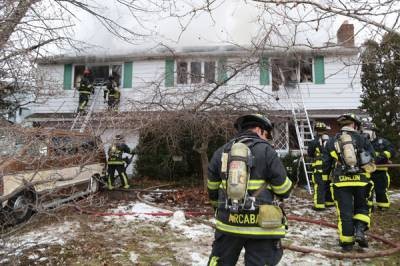One type of call that Fire, EMS, and Law Enforcement often respond to is the
[caption id="" align="alignright" width="229"] Ems response to Hoarding
“check the well being” of a occupant that has not made contact with family in a certain amount of time. Being called to check the well being of a person inside hoarding conditions can turn into a major incident it the responders enter ill prepared. Let’s take a look inside the hoarding environment to offer some insight for first responders tasked with going inside them looking for people that have not been communicating with their friends, family, or others.
Ensuring Occupancy
Before we go inside the hoarding environment, exposing ourselves to different dangers, we should take steps to determine if the person is still living there. Often, in hoarding conditions an occupant can fill their home until it is no longer inhabitable and just move out, that simple. If the home has become so full the occupant will often disconnect the utilities, whether their choice or the building inspectors choice, and move to a different location.
If the call comes in to check on an occupant and you arrive to find a potential Heavy Content Environment we should take some steps to find out if the home is still occupied.
- Have dispatch forward contact information to on scene responders for questioning
- Question neighbors
- Inspect utility meters
- Perform a 380 degree size up
- Look for access points (often NOT the front or back door)
Locating the Victim
Once the determination has been made that a person could be inside the hoarding it’s time
[caption id="attachment_883" align="alignright" width="200"]

Hoarding
to go looking for them. Understanding that hoarding can take over a home and prohibit occupants from sleeping in bedrooms or sitting in living room can help lead you to their locations. If you understand this complication we may start searching for occupants in different locations.
Example: Searching for an occupant after dark, we may start our search in the living room instead of the bedroom.
The best way of making access to trapped occupants will be to find their primary entrance points. If the home has filled the space around “normal” access points, such as doorways, they will often enter through windows or other means. Finding these entrances will be the best place to start looking for a missing person.
Using the only access points will lead you to the “goat paths” throughout the home. These pathways can lead directly to the occupant.
Warning: using these pathways EMS providers should start a search pattern when looking for occupants and try to keep the belongings in place. Keeping the debris from falling can be a difficult task as the pathways can be so narrow.
One way of making your travel through the pathways less destructive is to leave your bags outside the environment until the patient has been discovered. Without our bags across our shoulders it will reduce or profile and keep from knocking the stacks over. First responders should carry a small bag or the basic CPR mask just in case of impending need of CPR or rescue breathing. Keeping the bags outside the building will also reduce the need for decontaminating them as well.
EMS providers should use a coordinated search pattern to find the victims, much like firefighters would. Collapsed belongings could easily hide patients. Utilizing a primary and secondary search can help offer the occupant a larger chance of survival
Primary: Traveling the pathways looking for occupants quickly and efficiently. The primary search should be a quick and organized search.
Secondary: Secondary searches should be a slower search where individual piles of collapsed belongings that seem out of place or different should be inspected for occupants.
Review
Hoarding can present many challenges to first responders in all three divisions. Before entering a hoarded environment you should ensure the potential for occupancy and use an accurate size up to locate the victim. Finding people that are missing inside the massive amounts of belongings can turn a “routine” check the well being call into a technical rescue inside a Haz-Mat situation.
Start preparing for the call you will receive, not might receive. Hoarding is found in everyone’s district and it is an area that we need to review. Use this quick article for some thought stirring discussion and review your department’s policies on entering private residence on check the well being calls.

















